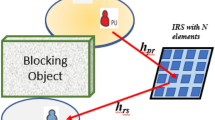Abstract
In spite of spectrum sensing, aggregate interference from cognitive radios (CRs) remains as a deterring factor to the implementation of spectrum sharing strategies. We provide a systematic approach of evaluating the aggregate interference (I aggr) experienced at a victim primary receiver (PR). In our approach, we model the received power versus distance relations between a primary transmitter (PT), PR, and CRs. CRs can spatially reuse a channel and thus two adjacent CRs are separated by the co-channel reuse distance (R). Our analytical framework differs from the existing ones in that we have formulated I aggr in terms of R and sensing inaccuracy. Energy detector is assumed for the purpose of spectrum sensing. I aggr is expressed explicitly as a function of the number of energy samples collected (N) and the threshold SNR level used for comparison (SNR ε ). This allows us to assess their impacts on I aggr. A numerical example is constructed based on the scenario of spectrum sharing between DTV broadcast and IEEE 802.22 Wireless Regional Area Network. Our analysis demonstrates the extents of which I aggr can be restricted, by increasing R or sensing accuracy (either by increasing N or decreasing SNR ε ), and the amount of increment required. Conditioned on the example scenario, the critical {N, SNR ε , R} values that fulfill certain regulatory requirement are revealed.









Similar content being viewed by others
References
Stevenson, C., Chouinard, G., Lei, Z., Hu, W., Shellhammer, S. J., & Caldwell, W. (2009). IEEE 802.22: The first cognitive radio wireless regional area network standard. IEEE Communications Magazine, 47(1), 130–138.
Andrews, J. G., Claussen, H., Dohler, M., Rangan, S., & Reed, M. C. (2012). Femtocells: Past, present, and future. IEEE Journal on Selected Areas in Communications, 30(3), 497–508.
Urkowitz, H. (1967). Energy detection of unknown deterministic signals. Proceedings of the IEEE, 55(4), 523–531.
Menon, R., Buehrer, R. M., & Reed, J. H. (2008). On the impact of dynamic spectrum sharing techniques on legacy radio systems. IEEE Transactions on Wireless Communications, 7(11), 4198–4207.
Chen, Z., Wang, C.-X., Hong, X., Thompson, J., Vorobyov, S. A., Ge, X., et al. (2012). Aggregate interference modeling for cognitive radio networks with power and contention control. IEEE Transactions on Communications, 60(2), 456–467.
Rabbachin, A., Quek, T. Q. S., Shin, H., & Win, M. Z. (2011). Cognitive network interference. IEEE Journal on Selected Areas in Communications, 29(2), 480–493.
Ghasemi, A., & Sousa, E. S. (2008). Interference aggregation in spectrum-sensing cognitive wireless networks. IEEE Journal of Selected Topics in Signal Processing, 2(1), 41–56.
Mahmood, N. H., Yilmaz, F., Alouini, M.-S., & Øien, G. E. (2014). Heterogeneous next-generation wireless network interference model—And its applications. Transactions on Emerging Telecommunications Technologies, 25(5), 563–575.
Rappaport, T. S. (2001) Wireless communications: Principles and practice (2nd ed.). Prentice Hall. ISBN: 0-13-042232-0.
Foo, Y.-L. (2013). Deployment of wireless regional area network and its impact on DTV service coverage. Annals of Telecommunications, 68(11–12), 691–703.
Foo, Y.-L. (2013). Cooperative sensing in wireless regional area network to improve DTV coverage prediction. Wireless Personal Communications, 72(4), 2339–2360.
Nuttall, A. H. (1975). Some integrals involving the Q M function. IEEE Transactions on Information Theory, 21(1), 95–96.
Code of Federal Regulations (C.F.R.) Title 47—Telecommunication, Part 73—Radio Broadcast Services, Subpart E—Television Broadcast Stations, Section 73.623—DTV applications and changes to DTV allotments, (2012).
Author information
Authors and Affiliations
Corresponding author
Rights and permissions
About this article
Cite this article
Foo, YL., Takada, Ji. Aggregate Interference of Equidistant Cognitive Radios. Wireless Pers Commun 92, 1053–1069 (2017). https://doi.org/10.1007/s11277-016-3592-2
Published:
Issue Date:
DOI: https://doi.org/10.1007/s11277-016-3592-2




